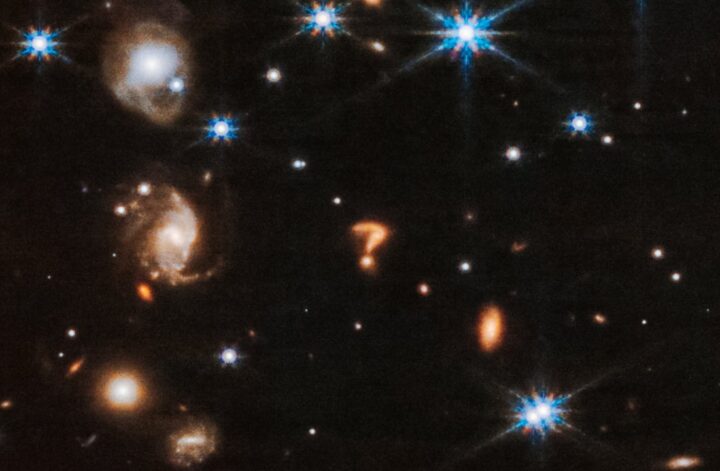Late last month NASA and ESA released a swirling infrared vista capturing an evolutionary snapshot of the formation of two nascent stars, known collectively as Herbig-Haro 46/47. As reported by Space Explored, it wasn’t long before eagle-eyed viewers noticed a perfectly formed question mark chilling in the star-studded periphery of the image.
Naturally, a question mark hanging in the inky depths of space raises, well, questions. IGN reached out to scientist Dr. Christopher Britt of the Space Science Telescope Institute to find out exactly what the unexpected interloper was, and how it came to form in the first place.

“The question mark is probably a pair of galaxies in the background which are merging together,” Dr. Britt explained. “As they approach and interact, the shape of each galaxy can be distorted, including by ripping out long streamers of stars and gas. For many galaxies, this happens multiple times as they grow, and our own Milky Way is no different.”
Dr. Britt noted a similar fate is expected to befall our own Milky Way in roughly four billion years, when it collides with the neighbouring Andromeda spiral galaxy. At this point the gravitational influences of the duelling monsters will pull and deform one another’s structures, until they eventually settle into a unified elliptical galaxy over the course of a few billion years.

The galaxies forming the question mark could be in the middle of a similar cosmic dance. “This particular pair is so far away, it’s hard to make out much detail, but there are some similar looking galaxy mergers that have been seen closer to us, including this one (below) called Arp 256 that also looks a bit like a question mark.”
Speaking about the James Webb Space Telescope (JWST), which was used to capture the image, Dr. Britt explained its large golden mirror and powerful infrared capabilities made it easier to spot the strange feature, and that other observatories, such the Hubble Space Telescope, would have required a “very deep exposure” to capture the sight.

“In this specific case, it’s important to consider that Hubble is sensitive to bluer light than Webb is, and Hubble can see only the shortest wavelength light that was included in this image (which is still infrared) with all the other greens and yellows and oranges and reds in the image being too far into the infrared for Hubble to see. As you can see from the colour image, this object is certainly easier to see the further into the infrared you go.”
For more stunning example of infrared astrophotography why not check out our gallery of the best JWST images captured to date.
Anthony is a freelance contributor covering science and video gaming news for IGN. He has over eight years experience of covering breaking developments in multiple scientific fields and absolutely no time for your shenanigans. Follow him on Twitter @BeardConGamer
